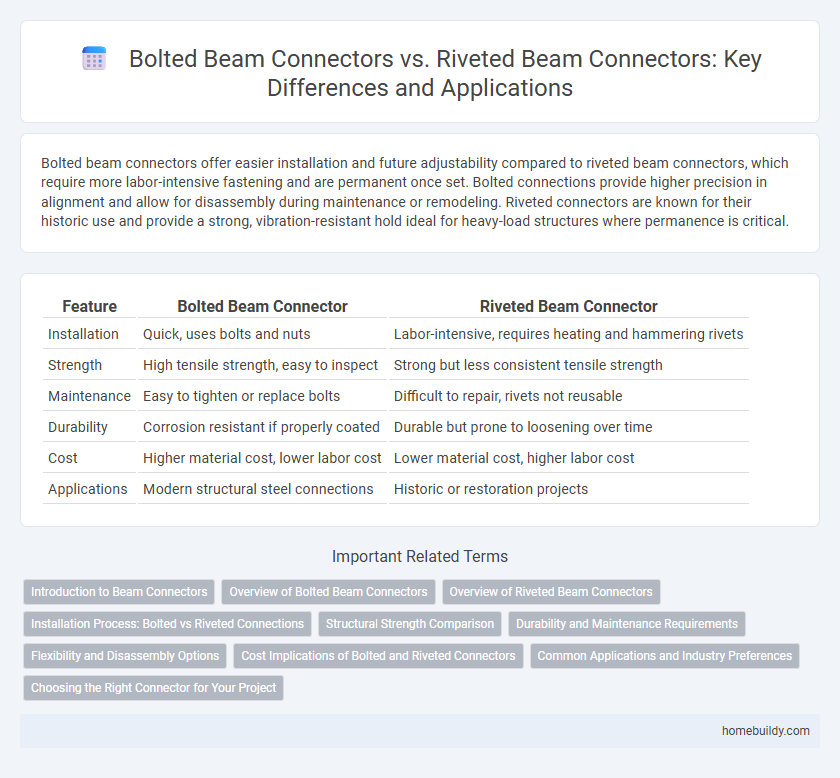Bolted beam connectors offer easier installation and future adjustability compared to riveted beam connectors, which require more labor-intensive fastening and are permanent once set. Bolted connections provide higher precision in alignment and allow for disassembly during maintenance or remodeling. Riveted connectors are known for their historic use and provide a strong, vibration-resistant hold ideal for heavy-load structures where permanence is critical.
Table of Comparison
| Feature | Bolted Beam Connector | Riveted Beam Connector |
|---|---|---|
| Installation | Quick, uses bolts and nuts | Labor-intensive, requires heating and hammering rivets |
| Strength | High tensile strength, easy to inspect | Strong but less consistent tensile strength |
| Maintenance | Easy to tighten or replace bolts | Difficult to repair, rivets not reusable |
| Durability | Corrosion resistant if properly coated | Durable but prone to loosening over time |
| Cost | Higher material cost, lower labor cost | Lower material cost, higher labor cost |
| Applications | Modern structural steel connections | Historic or restoration projects |
Introduction to Beam Connectors
Bolted beam connectors offer greater ease of installation and removal compared to riveted beam connectors, providing enhanced flexibility in structural adjustments. Riveted beam connectors, known for their historical reliability, create permanent and robust joints but require specialized labor and equipment. Modern construction increasingly favors bolted connectors for their efficiency, safety, and cost-effectiveness in beam-to-column connections.
Overview of Bolted Beam Connectors
Bolted beam connectors provide a secure and easily adjustable method for joining steel beams in construction, utilizing high-strength bolts to ensure structural stability and load transfer efficiency. These connectors offer advantages such as faster installation, reduced labor costs, and improved inspection capabilities compared to riveted connections. Their widespread use in modern steel frameworks highlights their reliability in accommodating dynamic loads and facilitating maintenance or structural modifications.
Overview of Riveted Beam Connectors
Riveted beam connectors are traditional structural fasteners used in steel construction that rely on heated rivets deformed to create a strong, permanent joint. Their design allows for effective load transfer and resistance to shear and tensile forces, making them suitable for heavy-duty applications. Despite being largely replaced by bolted connectors due to installation efficiency, riveted connectors remain valued in historic restorations and structures requiring high fatigue resistance.
Installation Process: Bolted vs Riveted Connections
Bolted beam connectors offer a quicker and simpler installation process compared to riveted connectors, as bolts can be easily tightened with standard tools, reducing labor time and skill requirements. Riveted connections require heating and hammering each rivet, which involves specialized equipment and longer curing times for secure fastening. The bolted method allows for faster adjustments and disassembly, enhancing onsite efficiency in structural assembly.
Structural Strength Comparison
Bolted beam connectors provide superior structural strength compared to riveted beam connectors due to their higher load-carrying capacity and ease of installation, ensuring consistent clamping force and reduced stress concentration. Riveted connectors, while historically significant, often exhibit lower tensile strength and greater susceptibility to fatigue over time, impacting overall structural integrity. The enhanced performance of bolted connections in shear, tension, and bending makes them the preferred choice in modern structural engineering applications.
Durability and Maintenance Requirements
Bolted beam connectors offer superior durability due to their high-strength steel bolts that resist loosening under dynamic loads, reducing the frequency of maintenance checks. Riveted beam connectors, while historically reliable, are prone to gradual rivet deformation and corrosion, increasing long-term maintenance demands. The bolted design simplifies inspection and replacement processes, enhancing overall structural integrity and lifecycle cost efficiency.
Flexibility and Disassembly Options
Bolted beam connectors offer greater flexibility in structural adjustments since bolts can be easily tightened or loosened, allowing for straightforward modifications during construction or future renovations. Riveted beam connectors provide a more permanent connection, limiting the ability to disassemble or reposition components without damaging the rivets. The bolted option supports efficient disassembly and reuse of beams, making it preferable in projects requiring adaptability.
Cost Implications of Bolted and Riveted Connectors
Bolted beam connectors typically offer lower installation costs due to faster assembly and reduced labor requirements compared to riveted connectors. Riveted beam connectors require specialized labor and equipment, increasing both installation time and overall project expenses. Maintenance costs for bolted connectors are generally lower, as bolts can be easily inspected and replaced without extensive disassembly.
Common Applications and Industry Preferences
Bolted beam connectors are widely used in modern construction projects for their ease of installation and strong load-bearing capacity, making them preferred in commercial buildings, steel frameworks, and modular construction. Riveted beam connectors remain common in restoration and historical building projects where maintaining architectural authenticity is critical, particularly in bridges and vintage industrial structures. The construction industry favors bolted connectors for faster assembly and maintenance efficiency, while riveted connectors are chosen in niche applications demanding high fatigue resistance and traditional aesthetics.
Choosing the Right Connector for Your Project
Bolted beam connectors offer superior strength, ease of installation, and adaptability for modern construction projects, making them ideal for applications requiring quick assembly and future disassembly. Riveted beam connectors provide a more traditional, permanent connection suited for historical restorations or situations demanding high shear strength without the need for frequent maintenance. Selecting the right connector depends on project requirements such as structural load, installation speed, and potential need for future modifications.
Bolted beam connector vs Riveted beam connector Infographic

 homebuildy.com
homebuildy.com